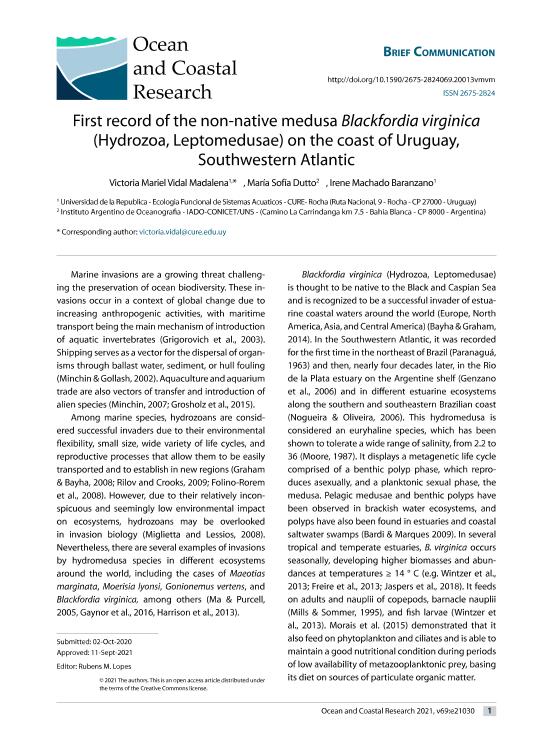Artículo
First record of the non-native medusa Blackfordia virginica (Hydrozoa, Leptomedusae) on the coast of Uruguay, Southwestern Atlantic
Fecha de publicación:
19/12/2021
Editorial:
Universidade de São Paulo
Revista:
Ocean and Coastal Research
ISSN:
2675-2824
Idioma:
Inglés
Tipo de recurso:
Artículo publicado
Clasificación temática:
Resumen
Marine invasions are a growing threat challenging the preservation of ocean biodiversity. These invasions occur in a context of global change due to increasing anthropogenic activities, with maritime transport being the main mechanism of introduction of aquatic invertebrates (Grigorovich et al., 2003). Shipping serves as a vector for the dispersal of organisms through ballast water, sediment, or hull fouling (Minchin & Gollash, 2002). Aquaculture and aquarium trade are also vectors of transfer and introduction of alien species (Minchin, 2007; Grosholz et al., 2015). Among marine species, hydrozoans are considered successful invaders due to their environmental flexibility, small size, wide variety of life cycles, and reproductive processes that allow them to be easily transported and to establish in new regions (Graham & Bayha, 2008; Rilov and Crooks, 2009; Folino-Rorem et al., 2008). However, due to their relatively inconspicuous and seemingly low environmental impact on ecosystems, hydrozoans may be overlooked in invasion biology (Miglietta and Lessios, 2008). Nevertheless, there are several examples of invasions by hydromedusa species in different ecosystems around the world, including the cases of Maeotias marginata, Moerisia lyonsi, Gonionemus vertens, and Blackfordia virginica, among others (Ma & Purcell, 2005, Gaynor et al., 2016, Harrison et al., 2013).
Palabras clave:
HYDROMEDUSAE
,
INVASIVE SPECIES
,
COASTAL ECOSYSTEM
,
URUGUAY
Archivos asociados
Licencia
Identificadores
Colecciones
Articulos(IADO)
Articulos de INST.ARG.DE OCEANOGRAFIA (I)
Articulos de INST.ARG.DE OCEANOGRAFIA (I)
Citación
Vidal Madalena, Victoria Mariel; Dutto, María Sofía; Machado Baranzano, Irene; First record of the non-native medusa Blackfordia virginica (Hydrozoa, Leptomedusae) on the coast of Uruguay, Southwestern Atlantic; Universidade de São Paulo; Ocean and Coastal Research; 69; 19-12-2021; 1-8
Compartir
Altmétricas




